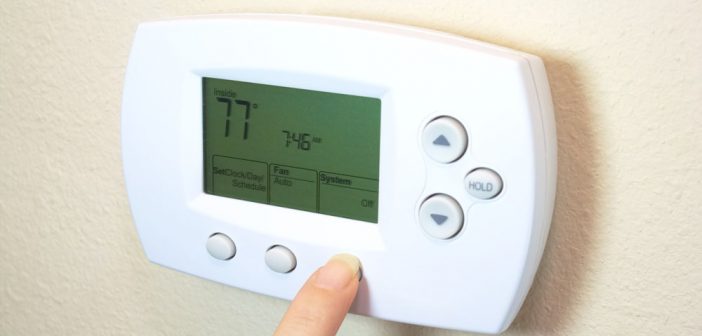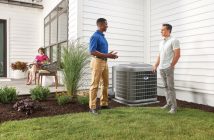One of the most important things to have as winter approaches is a furnace that is in good condition and ready to provide reliable service on the coldest days of the year. Poor maintenance can lead to breakdowns that leave the house dangerously cold for people, pets, and pipes.
Too many homeowners think that preparing the furnace for winter is just a matter of switching the system from “cool” to “heat”, but there are a number of steps involved in checking out your system and determining that it is really prepared for what is ahead. These easy actions will help you confirm that your furnace is as prepared as possible for the frigid weather ahead.
Examine the Thermostat
The part of the furnace we see the most is the thermostat. Situated safely on the wall somewhere in your home, the thermostat seems to give uninterrupted high performance. You just assume that when it needs to turn the system on, it will do so.
However, there are things that can go wrong with a thermostat. Calibration issues, accumulations of dirt, and even physical damage can cause the thermostat to operate incorrectly.
You should remove the thermostat cover periodically and examine it for buildups of dirt or other obstructions. It’s also good to have another thermometer close by to make sure that your thermostat is reading correctly. If you see any issues, it’s probably easiest to just replace the thermostat. While you’re doing that, be sure to get a programmable unit.
Adjust the Burners
Gas furnaces have a number of advantages. Their combustion process creates water vapor, which creates humidity that helps in two major areas. First, it makes the air more pleasant to breathe, reducing the symptoms of dry air in the sinuses. The increased humidity also creates a warmer “feels like” temperature.
With that said, gas burners need a little attention. Each year, they should be inspected for corrosion, cleaned, and adjusted. These tasks may be a little more than the average homeowner can do, so don’t hesitate to have a contractor conduct these tasks.
Cleaner burners use less fuel, last longer, and are less likely to create carbon monoxide gas. This simple step goes a long way toward saving money and increasing comfort.
Clean the Ducts
One of the most problematic areas in home cleaning is the HVAC ducts. This is especially true in northern regions, where many homes have a furnace for winter but no air conditioning. In these homes, there are many months out of the year when dust accumulates unchecked.
Simple cleanup can go a long way toward minimizing the impacts of dust. Routine dusting in the living space, combined with regular replacement of furnace filters, can dramatically reduce the accumulation of dust in the ducts. You can also help your cause by minimizing the amount of time that windows and doors are left open, and by simultaneously managing other dust sources like dryer lint traps.
Over the long term, though, professional duct cleaning may be required. A contractor can clean the accumulated dust inside your HVAC ducts, reducing the strain on your furnace – and your sinuses.
Seal Ducts & Air Passages
The greatest enemy of your heating system is lost air. It does you no good to have a well-maintained furnace generating clean, warm air if the air escapes into the attic, crawlspace, or outdoors.
Yet many homes have this very problem without even knowing it. The system quietly pushes air out through a gap in ductwork, sending warm air into places it doesn’t need to go and creating a deficit for the living space.
Turn on your system fan without the heat, then check your ductwork. Everything from stored items to energetic pets can cause gaps to open up between sections of ductwork, so use your senses of sight, hearing, and touch to detect these cracks. Then seal them tightly. Clean the adjacent areas of dust and dirt so that the adhesive will stick adequately, then seal the gaps with duct tape (remember, that’s actually what it’s for!)
Clean the Vent or Flue
As with any fuel-burning appliance, your furnace has exhaust that must be vented to the outside. It may be referred to as a vent, flue, stack, or even a chimney, but whatever the name, the job is the same. They carry the byproducts of combustion out of the furnace and vent them safely outside. These passageways can sometimes become clogged with leaves, bird nests, or other debris, reducing the size of the opening and slowing ventilation.
The results can be expensive and even dangerous. Poor ventilation can trigger a buildup of carbon monoxide in your home, and it can interfere with the proper mixture of oxygen and gas in the combustion chamber. Both of these situations can cause dangerous conditions.
Fortunately, flues are fairly easy to inspect. It’s usually just a simple matter of shining a flashlight inside and checking for obstructions or any kind of buildup. The hard part is getting access to it, and many people make it needlessly dangerous by climbing a ladder.
That’s not necessary. It is often easiest simply to remove the screws that join sections and visually check the interior from ground level. Try it at dusk so that there is less sunlight to interfere with your view. Use a broomstick or other improvised tool to clear away any buildup or blockages. Then reassemble the flue, sealing it with tape as needed.
Nothing is more critical to your comfort and safety during the winter than the proper functioning of your furnace, and nothing makes a bigger impact on your wintertime finances than its efficient performance. Getting the furnace ready for winter is a process that you should start long before cold air threatens. That way, you’ll have time to make necessary adjustments, cleaning, and repairs before it goes into full-time use.
These steps are simple enough for any homeowner to conduct, but never hesitate to get a professional’s assistance with prepping your furnace for winter.









